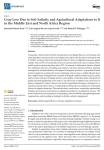Aryal J.P., Lopez-Lavalle L.A.B., El-Naggar A.H. (2025). Crop Loss due to soil salinity and agricultural adaptations to it in the Middle East and North Africa Region. Resources, 01/09/2025, vol. 14, n. 9, p. 139.
https://doi.org/10.3390/resources14090139
https://doi.org/10.3390/resources14090139
| Titre : | Crop Loss due to soil salinity and agricultural adaptations to it in the Middle East and North Africa Region (2025) |
| Auteurs : | J.P. Aryal ; L.A.B. Lopez-Lavalle ; A.H. El-Naggar |
| Type de document : | Article |
| Dans : | Resources (vol. 14, n. 9, September 2025) |
| Article en page(s) : | p. 139 |
| Langues : | Anglais |
| Langues du résumé : | Anglais |
| Catégories : |
Catégories principales 06 - AGRICULTURE. FORÊTS. PÊCHES ; 6.4 - Production Agricole. Système de ProductionThésaurus IAMM PERTE A LA RECOLTE ; PERTE ; SALINITE DU SOL ; ADAPTATION AU CHANGEMENT ; RENDEMENT DES CULTURES ; MOYEN ORIENT ; AFRIQUE DU NORD |
| Résumé : | Using data collected from 294 farm households across Egypt, Morocco, and Tunisia, this study quantifies crop losses due to soil salinity and analyzes the key factors associated with it. Further, it analyzes the factors driving the farmers' choice of adaptation measures against salinity. Almost 54% of households surveyed reported yield losses due to salinity, with a sizable portion experiencing losses above 20%. In response to salinization, farmers adopted five adaptation practices, including crop rotation, salt stress-tolerant varieties, drainage management, soil amendments, and improved irrigation practices. A generalized linear model is applied to examine the factors explaining crop loss due to salinity. Results show that a higher share of irrigated land correlates with greater salinity-related crop loss, particularly in areas with poor drainage and low water quality. Conversely, farms with good soil quality reported significantly lower losses. Crop losses due to salinity were much lower in quinoa compared to wheat. Farmers who received agricultural training or belonged to cooperatives reported lower losses. A multivariate probit model was employed to understand drivers of adaptive behaviors. The analysis shows credit access, cooperative membership, training, and resource endowments as significant predictors of adaptation choices. The results underscore the importance of expanding credit availability, strengthening farmer organizations, and investing in training for effective salinity management. |
| Cote : | En ligne |
| URL / DOI : | https://doi.org/10.3390/resources14090139 |







